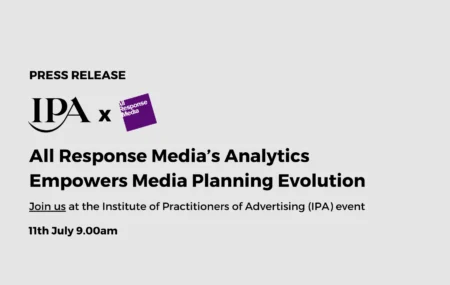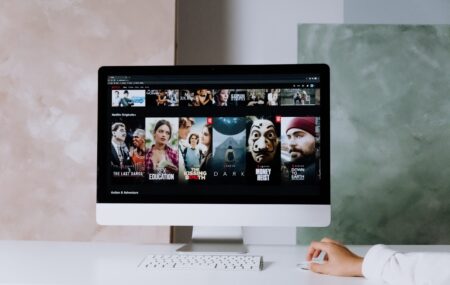“The media landscape is undergoing a profound transformation, driven by the rise of short-form content, advanced targeting technologies, and the integration of AI in creative processes. Advertisers must navigate this by embracing multi-channel strategies and understanding the nuanced states of consumer engagement. The shift towards TV over IP, VOD services, and the increasing prevalence of digital and connected audio platforms present both challenges and opportunities for more precise and impactful advertising.
As the market continues to evolve, CMOs need to stay agile, continuously testing and refining their approaches to balance broad reach with targeted efficiency. Leveraging AI for creative optimisation and capitalising on emerging trends like DOOH and programmatic audio will be crucial. By adapting to these changes and strategically investing in diverse media channels, advertisers can effectively capture attention and drive meaningful engagement in an increasingly competitive landscape.”
1. Media Innovation & Future Gazing
Attention in the Media Landscape
Develop and distribute short, engaging content tailored to capture fragmented audiences. Invest in creative teams or agencies specialising in short-form content to ensure high engagement and relevancy.
Attention is becoming increasingly difficult to capture in the current fragmented media landscape. Since 2015, the rise of this trend has influenced other platforms like Meta’s Reels and YouTube Shorts, leading to a broader industry shift towards shorter, more engaging content formats. Just recently, Twitch also announced that they’re launching their version of the discover feed. Smartphones have been significant in this, with 20-32% of all adults and over half of 16-34-year-olds spending substantial time on their devices. This shift has led to a more fragmented marketplace, making it challenging for advertisers to capture attention. One notable example is TikTok, which has reshaped attention dynamics with its short-form, scrollable content, which no doubt has influenced channels like YouTube, Twitch, Meta, etc to follow suit.
How to Maximise Attention Through Audience Segmentation
Segment your audience based on three states (Work, Rest and Play) and tailor your messaging accordingly. Use data analytics to identify when and where your target audiences are most receptive to your brand messages and optimise your media planning to align with these insights.
To maximise attention, it’s crucial to understand the different states in which consumers engage with media—Work, Rest, and Play. When consumers are relaxed and in a happier frame of mind, they are more receptive to advertising messages, particularly brand messages. On the other hand, if you’ve got to renew your car insurance for example, you will still do that regardless of your state. This understanding helps in targeting advertising effectively, considering the consumer’s state of mind and the media channels they are likely to use during those states.
Our research shows us that if you compare media consumption 10 years ago to media consumption now, back then, you could run a TV campaign and hit 85%, if not more, of your target audience from just one TV campaign. You can’t necessarily do that now. You can still hit a huge number, but what you need to do is have different media channels to add the incremental gain. That means competing in lots of different spaces in lots of different formats to help cut through and grab the consumer’s attention in what is an increasingly competitive world.
What to Consider From The Shift in TV and Video-On-Demand (VOD) Services
Allocate a small test budget across different media channels to maximise reach and engagement based on the data available on your audience’s state of mind. Only then can you find the most effective mix for your campaigns.
With about 1.5 million homes in the UK using TV over IP, this number is expected to double by the end of 2024. This shift is significant for both broadcasters and advertisers, enabling more precise targeting and contextual advertising. Services like ITVX, Channel 4, and Sky’s AdSmart are adapting to these changes, offering more granular targeting options. At the minute, it’s quite difficult to differentiate success from one channel to the other because they’re just measured, looked at and bought differently. However, we do expect this to change soon.
Another shift we expect to see with TV is that long-term it will begin mirroring the digital landscape or the traditional digital landscape. That means much more tailored in terms of what you can deliver, whether it’s linear TV itself or increasing the BVOD platforms as they continue to grow. One thing we’ve seen from our side, doing VOD campaigns with the major broadcasters, is that just because you can target, it doesn’t always mean that that will be better.
The more targeted you go (with any media), you’ll pay more for the privilege of targeting highly, and we don’t always see the efficiency of that depending on what campaign metric you’re measuring. Sometimes, wastage is good and broader is good, and you can still deliver collective activity. We’ve seen that with the major broadcasters, where they’ve opted for a more regional campaign as opposed to a very audience demographic targeted campaign. It’s worth remembering the need to test different types of approaches for targeting within the tv space and to find a balance between broad versus more targeted.
What are the Challenges and Opportunities in the Subscription VOD Market?
There are advanced targeting options provided by services like ITVX, Channel 4, and Sky’s AdSmart. Balance targeted campaigns with broader approaches to ensure cost-efficiency and avoid excessive targeting costs without significant returns.
The subscription VOD market, including players like Netflix, Disney+, and Amazon Prime Video, has seen significant growth over the past six to seven years. However, there has been a plateau in the last 12 months, likely due to the cost of multiple subscriptions and the current cost of living crisis. This plateau indicates a potential for consolidation in the market, with content aggregators providing a more streamlined service for consumers.
As subscription fatigue sets in, VOD services are increasingly introducing advertising options. Netflix, Disney+, and Amazon Prime have all launched advertising routes, providing new opportunities for advertisers. The sophistication of targeting varies, with Amazon Prime leveraging its extensive data ecosystem to offer highly targeted advertising, while others are still refining their offerings. Amazon for example, can target everything from regionally where you are, to life stage based on what you’re buying, to disposable income based on how much you’re spending.
On the other hand, Netflix launched without having a proper product selling to the market and they erroneously assumed brands would be willing to pay quite high CPMs just for the privilege of being on Netflix. Now, they’re refining that because they’ve realised brands don’t want to spend a high CPM just to be on Netflix with no targeting.
Artificial Intelligence in Creative Advertising
Get your team to adopt AI tools to streamline the simplest of workflows, often the ones that take the most time, or even to plug in a skillset gap like design for example. Automate and optimise creative production and get your agency to test AI-generated content variations to identify the most effective creatives, reducing wastage and production costs.
Artificial intelligence (AI) is set to revolutionise creative advertising. Giants like Google and Meta are revolutionising the way campaigns are run. They’re encouraging brands to consolidate their efforts into one comprehensive campaign, allowing sophisticated algorithms to take the reins. This AI-driven approach is designed to identify and engage the most relevant audience for any given message.
Recently, while exploring Meta’s platform, it became evident that the company is nudging advertisers towards ‘Advantage Plus’—their algorithmic solution that simplifies campaign management. However, this shift towards automation makes manual data analysis and audience sizing increasingly challenging.
For years, the industry mantra has been to cast a wide net—embracing some level of wastage for the sake of cost efficiency. Only recently have Google and Meta acknowledged this strategy, integrating it into their AI algorithms. But the true innovation lies beyond bidding strategies; it’s in the creative domain where AI is set to make its mark.
Google and Meta are on the cusp of introducing tools that will generate diverse creative content through AI. Brands will be able to input their assets—products, logos, fonts—and the system will generate a plethora of creative variations. While branding may continue to focus on high-level storytelling and quality, performance marketing is expected to leverage dynamic, AI-generated creatives to optimise engagement.
The challenge for advertisers will be managing the need for varied creative content without squandering their production budgets. Creative agencies report that up to 80% of the content they produce for brands goes unused. AI could be the game-changer, enabling the rapid creation of content variations at a fraction of the cost.
2. Maximising Your Effectiveness in Direct Response Advertising
In today’s fast-paced marketing landscape, achieving success in your direct response campaigns require a delicate balance of creativity, strategic planning, and precise execution. This blog draws on extensive industry experience from two of our directors, who provided insights into how you can maximise the effectiveness of your direct response and performance marketing campaigns.
Creative is Crucial
No matter how well-crafted the media plan is, the wrong creative can severely hinder your campaign’s performance. One thing we often see in our Creative Review Sessions (LINK) is creative that doesn’t have a clear CTA. A clear call to action is essential in most creative pieces. The CTA must direct your audience on the specific steps they need to take, whether it’s visiting your website, making a phone call, or going to a store. This call to action should be re-iterated throughout the campaign to ensure clarity and consistency.
Alongside that, incorporating customer testimonials and reviews can significantly boost viewer confidence in your brand. Featuring real customers or showcasing high trust pilot ratings within your ads will add credibility and re-assure potential clients who are in the consideration stage.
If your brand sells direct-to-consumer, special offers and incentives (such as Black Friday deals or introductory discounts) can drive higher response rates by creating a sense of urgency. This urgency can be further amplified with countdowns or time-sensitive messages like ‘deal expires in 2 days’ prompting immediate action from viewers.
For TV campaigns, the ‘closed-eye test’ is a very useful way to test if you can understand the ad without seeing it. Given that many viewers engage in other activities while the TV is on, the voiceover must be clear and compelling. It should effectively convey the message even if the audience isn’t fully visually engaged. These principles (though particularly relevant to TV) apply across various media channels, including radio, print, and online video, with each medium having its own specific nuances.
Effective Planning and Targeting
Taking an audience-first approach is vital in the planning process, deciding whether to go broad or narrow with your targeting. The cost per thousand (CPM) impressions is a key consideration here as well. More targeted campaigns typically come with higher CPMs, so balancing specificity with cost-effectiveness based on your campaign objectives is something you need to consider.
With that, channel selection must align with your audience’s media consumption habits. For instance, older audiences might be better reached through direct response TV and specific Sky channels, whereas younger demographics might be better reached on social media.
Understanding these consumption patterns ensures your message reaches the right people at the right time. Our in-house developed tool, WorkRestPlay, is instrumental to us in this process in helping us plan our media campaigns. It helps identify key moments and mindsets to reach your audience effectively across different channels. By understanding when and how your audience interacts with various media, you can tailor your approach to maximise both the engagement and response rates.
Measurement and Optimisation
A robust measurement and test-and-learn framework is needed for any successful performance-focused campaign. Our recommendation would be starting with smaller budgets to gather initial learnings before scaling up. This approach allows you to identify what works without significant upfront investment. This is why testing is one of the most important things you can do early-on. Focus on high-impact elements first and avoid testing too many variables simultaneously to make sure that your findings are clear and actionable without the confusion of overlapping influences.
You may also want to use business insights to inform your testing and optimisation strategies. For example, with some of the travel clients we work with we find the weekends and Monday is often important. Though they’re not responding immediately on the weekend, we find the activity on the weekends really drives that latent response on the Mondays. Understanding peak response times around payday or specific day-of-week trends can significantly enhance your campaign’s effectiveness and is something you should monitor.
Channel Mix and Harvesting
The effectiveness of advertising can differ depending on the platform used, which is why testing and trialling to find the right mix of channels for your audience is critical. Paid search is often a foundational channel for many brands due to its effectiveness at lower-funnel conversions. Social media, despite some declines in effectiveness, remains an important performance channel. Platforms like Meta still offer significant reach and engagement opportunities.
Pay-per-click (PPC) is often referred to as a ‘harvesting channel’ because it captures the audience’s interest generated by other forms of media, like television. For instance, when a TV advert grabs someone’s attention, they often turn to online search engines to find out more. That’s why it’s crucial to ensure that your online adverts match the message of your TV campaign.
Similarly, social media campaigns should be in harmony with what’s happening on other channels. It’s not just about co-ordinating different platforms; it’s also about fine-tuning within the same medium. On television, for example, we sometimes use shorter adverts to capitalise on the curiosity sparked by longer ones. Even on popular shows like ITV’s morning programme, placing several short adverts can lead to a better viewer response compared to longer adverts shown throughout the day on various channels.
In essence, it’s all about leveraging the initial interest generated by big mediums like television and making sure that all your advertising efforts across different channels are working together to enhance the impact of that interest. This integrated approach helps to maximise the overall effectiveness of your advertising strategy.
Conclusion
A successful campaign requires a range of things, from creating compelling and actionable creative content to strategically targeting the right audiences and meticulously measuring and optimising performance. Hopefully these insights will help you to drive higher engagement, improve response rates, and achieve significant business outcomes. For further assistance or to discuss your specific needs, feel free to reach out to our marketing team or your client teams.
The Changing Landscape of the TV Industry: An Insider’s Perspective
The State of Traditional TV in 2023
2023 has been a particularly challenging year for traditional broadcasters in the TV space. Caroline McCall, the CEO of ITV, called it the “worst advertising recession since 2008”. Earlier in the year, Channel 4 announced 200 redundancies. This turmoil reflects significant shifts in the industry.
Viewing Figures and Revenue
As we move further into 2024, we’ve gained better insights into last year’s viewing figures and advertising revenues. Overall, linear TV saw revenue drops between 8% and 12%. ITV and Channel 4 experienced some of the largest declines, while Sky was somewhat cushioned from that by Premier League football.
Looking ahead, 2024 appears slightly more positive with expected growth of around 1-2%, though this won’t fully compensate for the declines in 2023. Viewing figures for linear TV continue to drop, particularly for Channel 4 and ITV. Channel 4 saw a 7% decline in adult viewing and over 16% in the 16-34 age group. Now, we see that viewing is dropping from a linear perspective, but we are seeing that move to more digital services.
Shifting Towards Digital Services
With the decline in linear TV, there’s a notable shift towards digital services like broadcast VOD (BVOD) and subscription VOD (SVOD). Platforms such as ITVX, Channel 4’s All 4, Sky OnDemand, and others are gaining traction. According to IPA touchpoints data, 7-9% of the average adult’s viewing time is now spent on these digital services.
Investment Challenges for Traditional Broadcasters
Traditional broadcasters face difficulties in investing in new quality content due to revenue declines. Competing with American giants like Netflix and Amazon Prime (which have large budgets for new productions consistently) is particularly challenging. Channel 4 faced criticism for cutting back on new content investment, opting instead for more repeats. However, successful productions like ITV1’s “Mr. Bates vs. the Post Office” earlier this year, demonstrate there’s still strong demand for compelling content from traditional broadcasters.
The Role of Subscription VOD Services
Most households now subscribe to at least one SVOD service. Nearly 60% of UK homes have Netflix, around 45% have Amazon Prime, and Disney+ is also growing with approximately 7.6 million subscribers. However, the cost-of-living crisis makes it difficult for consumers to maintain multiple subscriptions. To mitigate that affordability issue, Netflix and Amazon have introduced ad-supported services. While Netflix’s ad-supported launch faced challenge (lower than expected viewer uptake and difficulties delivering ad campaigns) it’s a step towards making these services more accessible. The investment required for testing on Netflix’s platform remains high, with some campaigns needing upwards of £500,000.
The Fragmented CTV Market
The CTV market is large and fragmented, encompassing BVOD, YouTube, Amazon Prime, to name a few. This fragmentation presents challenges for media planners in achieving continuity and consistency across formats, platforms, and measurement. When it comes to measuring incremental reach across linear TV and across BVOD, there’s definitely a lot of developments happening, one example being CFlight the new BARB scheme. However, advertisers should approach CTV with caution. While linear TV continues to perform well (especially for older audiences), younger viewers are increasingly turning to VOD and CTV. Advertisers might find value in BVOD platforms like All 4 and ITVX, which offer clearer targeting and pricing.
The Potential of Amazon Prime’s Ad-Supported Service
A significant development for 2024 is Amazon Prime’s move to include advertising by default. This change will create numerous advertising opportunities, and we are closely monitoring this development to understand its implications.
The Enduring Value of Linear TV
Despite the rise of VOD, linear TV remains valuable. Its measurement and optimisation capabilities, supported by BARB’s gold standard data and our in-house tools like Armalytics, are currently superior to those of VOD. With that, we can measure spot-by-spot level, and get some really good and fast insights, and we are able to optimise spot-by-spot to those insights. Alongside that, its high engagement level means it’s still a great way to get an audience’s attention. Lastly, linear TV also tends to be more cost-effective, maintaining its importance in advertising plans.
Conclusion
Though the TV market is undergoing significant changes (with both challenges and opportunities) at All Response, we are always keeping an eye on any developments or opportunities so that we can always stay ahead. If you have any questions or need further information, please reach out to our client teams or marketing team.
Get in touch with our team today
Find out how we can combine digital, TV and data science expertise to get the most out of your advertising budget.
"*" indicates required fields
 16 min read
16 min read 4 July, 2023
4 July, 2023 by Liam Cogan
by Liam Cogan

















